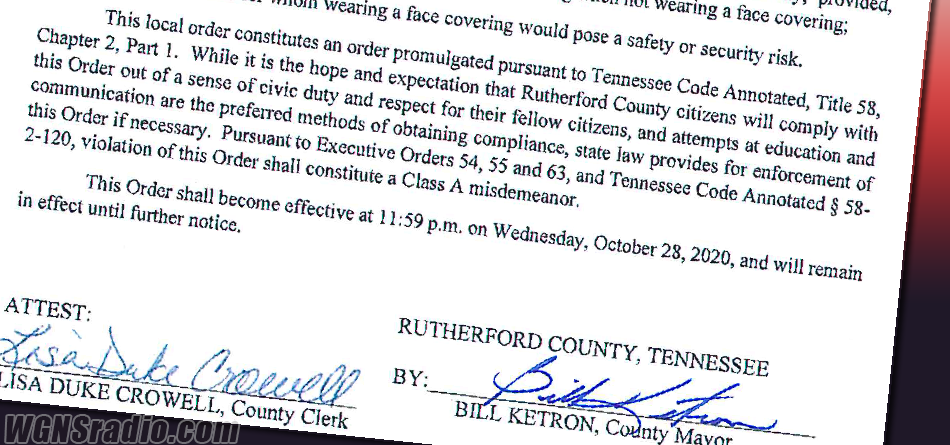As of November 12th, Rutherford County has 1,610 active COVID-19 cases. Since the start of the Pandemic, Rutherford County has seen 14,425 total cases and 129 deaths. Currently, 187.7 new cases of COVID-19 were reported over the past 7 days. Rutherford County is listed as a "Red Zone" for the pandemic.
A Red Zone is an area where new cases come in at 101 per 100,000 people and a lab test positivity result at or above 10.1%.
A face covering order remains in effect for Rutherford County as of the most recent mandate issued on OCtober 20, 2020. The mandate is in place until further notice.
Across the state, Tennessee areas where mask requirements were instituted over the summer have substantially lower death rates due to COVID-19 as compared to areas without mask requirements, according to a new analysis by Vanderbilt Department of Health Policy researchers.
“This analysis shows that strategies, including but not limited to masking while in contact with others, can have real impact on people’s lives,” John Graves, Ph.D., Director of the Center, said. “Mask mandates are associated with greater mask wearing and other behaviors like limiting close contacts with others, and the combined impact is clear and substantial.”
The study uses data on COVID-19 deaths by date of death, not the date the death was reported, which can lag the actual date of death by several weeks. The researchers note that due to these lags, Tennessee’s current view of COVID-19 deaths really only represents a clear picture of deaths through the first week of October—meaning that many of the deaths reported each day are tied to infections that occurred in September, before the recent surge in cases of COVID-19 in Tennessee.
The analysis expands on other analyses that Graves, along with Melinda Buntin, PhD, Mike Curb Chair of the Department of Health Policy, and Melissa McPheeters, PhD, MPH, research professor of Health Policy and Biomedical Informatics, have conducted about the implementation of mask requirements and hospitalizations.
As of Nov. 10, approximately 63% of the state’s residents lived in areas where a mask is required, while the remaining 37% lived in an area where masks were never required (8%) or lived in areas where mask requirements expired.
Death rates were initially higher in the areas where masks became required, the analysis found. In the weeks after mask requirements were put in place, areas where masks were required showed sharper declines in deaths per 100,000 population compared to areas where masks were never required.
“Deaths are a lagging indicator, following increases in cases and then hospitalizations, so we expect any intervention such as a mask requirement to take some time to demonstrate effectiveness. Rising rates of COVID-19 are a big ship to turn, and it is important to act early enough to be effective,” McPheeters said.
“As of the first week of October, there were more than four deaths per 100,000 population in areas where masks were never required and near or below two deaths per 100,000 in areas that adopted a mask requirement over the summer,” Buntin said.
The good news, researchers noted, is that more than 80% of Tennesseans were reporting as of Nov. 5 that they are wearing masks, according to research cited in the analysis from Carnegie Mellon University. The analysis notes, however, that mask wearing may be inconsistent, especially when around close family and personal contacts.
“Individuals may not understand the risk of exposure to friends and family and may ‘let down their guard’ in situations where they are meeting in small groups with close contacts,” the researchers concluded. “Mask ordinances demonstrate leadership by sending a clear signal that behavior must change to mitigate spread of the virus.”





